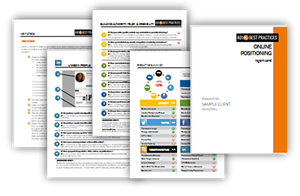 Google your name. Go ahead. I’ll wait…
Google your name. Go ahead. I’ll wait…
Then pull up your website, your LinkedIn profile and any other social media platforms where you have a presence and think about the following:
- What does your online presence say about you?
- What will plan sponsors think about your qualifications and professionalism when they visit your website or your LinkedIn profile?
- Will your online presence help or hurt your chances of winning new business?
In today’s age of 24/7 connectivity, your prospects will most certainly look you up online at some point during the sales process. While you may be able to walk the walk with your knowledge, experience and process, your website and social media profiles will tell a different story if you haven’t taken the time to position yourself as a 401k specialist.
A while back when I was developing the Positioned 4 Growth Workshop, and when going through it live when it first launched, each attendee received a personalized Online Positioning Report Card.
 After reviewing 20 advisors’ online profiles, what I found was that the average advisor has done about 30% of what’s needed to create a professional image that builds authority, trust and credibility online. This means there is a lot of room for improvement and for those that take a few steps now to enhance your online presence, it provides an opportunity to stand out above the competition.
After reviewing 20 advisors’ online profiles, what I found was that the average advisor has done about 30% of what’s needed to create a professional image that builds authority, trust and credibility online. This means there is a lot of room for improvement and for those that take a few steps now to enhance your online presence, it provides an opportunity to stand out above the competition.

NOW OPEN – the INSTANT AUTHORITY Live Workshop where I’ll walk you through building an online presence that positions you as a trusted 401(k) expert and authority.
Click here to learn more.
Five online positioning tips
Let me share with you a few simple things you can do that don’t necessarily require a lot of time and effort to apply, but can greatly impact how you’re perceived online.
1. Professionally brand your website and profiles
The first thing people notice when they visit your website or your social media profiles is your branding. You want to have a professional, consistent brand across all platforms which includes:
- Logo – You need a professional, easily recognizable logo.
- Colors – Your website and images should have a consistent color scheme (background, header titles, etc.) that compliments your logo.
- Your picture – You need a current, professional (but approachable) picture of you for your site and social media profiles.
Here’s a great example of how Greg at Gregory Ricks & Associates displays consistent branding across all platforms: (click image to view larger) (NOTE: Greg doesn’t have a valid SSL certificate installed on his site which is why you get a scary sounding error message when visiting his page – don’t let that happen to you – contact your website provider and make sure your site is using https and a valid security certificate.)
2. Ensure consistent messaging across all platforms
The next thing people look at or look for on your website is to figure out who you are, what services you’re offering, and what’s in it for them. This makes it critical that your message is clear, consistent across all platforms, and includes the following:
- Target audience – Identify who is your ideal client and make sure this message comes across online. You want to speak to your target audience and let them know they’re in the right place.
- Your value proposition – Include your value proposition or shorter value-statement (sometimes referred to as your brand slogan) that explains what benefit or outcome you help your clients achieve. This should be one of the first things people see on all of your online platforms.
- Call to action – On every platform, make it clear what your visitor should do next. You can change your website and your social media profiles into lead generating magnets by giving something away that solves a problem, addresses a challenge, or fills a need that you KNOW your ideal client has. Put it behind a subscription form to collect contact info and tell them how to access your giveaway with a strong directive that stands out, such as “Download the Report Now”.
The online profiles of Matt from Mom and Dad Money provide a great example of not only brand consistency, but a clear message and call to action (“Get the Roadmap”). Notice how Matt’s message “Helping new parents build happy families by making money simple” is on all platforms. (Click image to view larger.)
Once you have the branding and messaging down, the next thing I’d recommend is to identify ways you can add authority, trust, and credibility builders to your online profiles that position you as a 401k specialist.
3. Include authority builders
To build authority as a 401k specialist, it helps to be seen as the expert and educator and the way you can do this online is by incorporating the following items:
- Credentials – Completing advanced training and earning retirement designations makes you much more qualified than advisors that have not received any specialized training when competing for 401k business. Be sure to include your credentials in your online profiles and expand on the descriptions in your LinkedIn profile.
- Recognition or Awards – If you’ve received any awards or been nominated for industry specific recognition or roles, include this information on your profile as well. Until you’ve achieved this level of success, join retirement industry organizations like NAPA or the PSCA and add this information to your profile.
- Education – Another way to be seen as a subject matter authority is to teach. You can do this by offering workshops, webinars, videos or even through publishing articles, white papers and blog posts to your website and to your LinkedIn profile.
4. Include credibility builders
Building credibility online is not much different than how you’d build credibility in person. Consider the following:
- Professional Appearance –Your online image says a lot about you and your level of professionalism. If you have a cluttered, inconsistent and incomplete online presence, you’ll come across the same way as if you’ve shown up for a job interview in wrinkled pajamas. Dress for the job you want, or so the saying goes. Make sure your online profiles all have a consistent brand, professional image, photos that are of real people and places relevant to your practice (NOT stock images), a clean logo, is easy to navigate, is updated and current, etc.
- Authentic – When you speak in an authentic voice, you come across as more believable than when you try to use complex words, industry jargon, or an overtly professional tone that you’d never use when talking to your prospects face to face. Check the content on your website and LinkedIn summary. Make sure that it’s written to speak to your audience (not in the third person) using the word “you” twice as much as the word “I”. Keep a conversational tone and let your personality shine through.
- Include your “Why” –What is the reason you are in the business? Why do you feel the services you offer are important or why have you chosen to work with your niche client? When you share your “why” it gives people a chance to diffuse the typical apprehensions about being sold to and can create a bond or connection as you tell your story.
5. Include trust builders
If you want to build trust with your prospects online, this is where you need to get down to specifics.
- Case Studies – Share the results of the work you do by providing case studies or scenarios of how you’ve helped your clients address specific challenges or improved their plan.
- Client List or Logos – If your compliance department allows it, get written permission from your corporate clients to use their logos in a representative client list on your website, just as you would in your pitch book.
- Specific Statistics and Examples – Cite specific regulations, case law, or studies to prove and reinforce the points you make in your online education articles. Link to independent surveys, studies, or sources on your site that make a case for the value of the services you offer. For example, if you list investment policy statement support as a service you offer or discuss this topic in a webinar or on your blog, you might link to Fred Reish’s white paper “Managing Defined Contribution Plan Investment Policy Statements” as a credible source to confirm and reiterate the importance of this item.
Here’s a great example of how Cafaro Greenleaf includes case studies, awards, and a sample client list to build authority, credibility and trust. (Click image to view larger.)
Position yourself online as a credible 401k specialist
There’s no doubt that how you appear to prospects online can potentially win or lose you business. It’s not difficult to position yourself as a professional, credible 401k specialist by taking some time to create a professional brand, consistent message, and add authority, trust and credibility builders to your online profiles.


